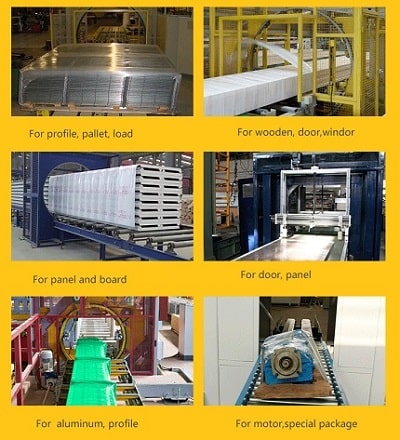Optimizing Logistics: Understanding Profile Orbital Stretch Wrapper Packing Lines
Handling and packaging long, often cumbersome products like aluminum extrusions, steel beams, plastic pipes, or timber requires specialized solutions. A profile orbital stretch wrapper packing line offers an automated, efficient, and protective method for securing these items for transport and storage. This technology plays a crucial role in modern manufacturing and logistics, minimizing damage and streamlining operations.
How Profile Orbital Stretch Wrappers Work
Unlike traditional pallet wrappers, orbital stretch wrappers (also known as horizontal wrappers) are designed specifically for elongated items. The core principle involves passing the product horizontally through a rotating ring or arm that carries a roll of stretch film.
Key components and the process typically include:
- Infeed/Outfeed Conveyors: Automated systems transport the profiles into and out of the wrapping station.
- Rotating Ring/Arm: This holds the stretch film roll and dispenser (film carriage). It rotates around the profile as the product moves longitudinally.
- Film Carriage: This mechanism controls the pre-stretch and application of the film, ensuring consistent tension and optimal material usage. Advanced systems often feature powered pre-stretch capabilities.
- Clamping and Cutting: Automated systems clamp the film at the start of the cycle and cut it upon completion, preparing the machine for the next product.
- Control System (PLC): Programmable Logic Controllers manage the wrapping parameters, conveyor speeds, film tension, and safety interlocks, allowing for customized wrapping recipes for different product types.
This orbital motion ensures the stretch film is applied tightly and uniformly around the entire length and circumference of the product bundle, creating a secure, cocoon-like package.
Key Features and Operational Advantages
Selecting and implementing a profile orbital stretch wrapper involves considering several factors:
- Wrapping Technology: An orbital stretch wrapper utilizes stretch film applied via an orbital motion to securely encase products. This method provides a tight, even wrap crucial for stability and protection.
- Product Compatibility: These systems are specifically engineered for the unique dimensions and shapes of long structural profiles, including items with substantial lengths, varying widths, and irregular cross-sections.
- Core Components: A typical line includes conveyors or a turntable for product handling, a film carriage system to dispense the stretch film accurately, and precision-controlled wrapper arms or rings orchestrating the orbital wrapping motion. Programmable Logic Controllers (PLCs) and comprehensive safety features are integral.
- Wrapping Customization: Operators can select single or multiple layers of film for tailored protection. Precise control over film overlap prevents product surface exposure and potential damage. The tight wrap significantly reduces the risk of profile movement or bundle collapse during handling and transit.
- Material Selection: Common stretch films include polyethylene (PE) and polypropylene (PP). For heavy or bulky profiles, thicker gauge films (e.g., 50-100 microns) offer enhanced durability. Features like perforated film or tear-off tails can facilitate easier unpacking.
- Capacity and Scalability: Systems vary widely in capacity, handling product lengths from a few meters up to 15 meters or more, and load capacities ranging from under one tonne to over ten tonnes. Larger capacities generally correspond to higher equipment investment.
- Efficiency and Protection: Profile orbital stretch wrapper lines deliver an efficient, durable, and economical packaging solution. They are vital for preventing physical damage, corrosion, contamination, and maintaining the dimensional stability of profiles during shipping and warehousing.
- Industry Applications: These wrappers are essential in industries handling long items, such as construction (aluminum, steel, PVC profiles), industrial manufacturing, metal service centers, and other sectors processing lengthy materials.
- System Configuration: While high-capacity lines require dedicated floor space in manufacturing or warehouse facilities, more compact, sometimes portable, profile wrapping machines are available, offering flexibility but typically with lower throughput and automation levels.

Benefits Beyond Basic Wrapping
Implementing an automated orbital wrapping line offers significant advantages:
- Enhanced Product Protection: Shields products from dust, moisture, UV radiation (with specific films), scratches, and other transit-related damage.
- Improved Load Stability: Tightly unitizes bundles, preventing shifting and potential safety hazards during handling.
- Reduced Labor Costs: Automation minimizes the need for manual wrapping, freeing up personnel for other tasks.
- Material Savings: Controlled pre-stretch capabilities can optimize film usage compared to manual methods.
- Increased Throughput: Automated lines operate consistently and often faster than manual processes, boosting overall packaging efficiency.
- Professional Presentation: Uniformly wrapped products present a more professional image to end customers.
Investing in a profile orbital stretch wrapper packing line is a strategic decision for businesses dealing with long products, enhancing product integrity, operational efficiency, and safety throughout the supply chain.
Explore options for an aluminum profile orbital stretch wrapper packing line.